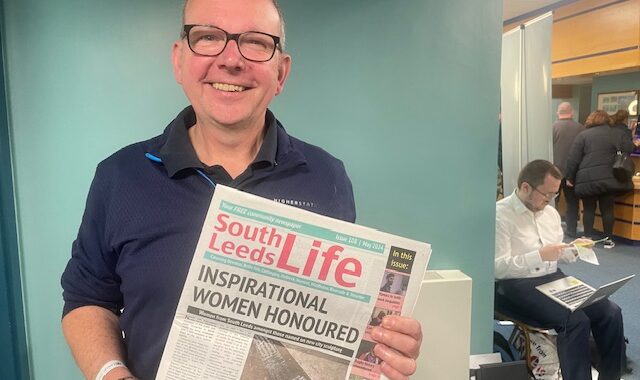After five years at the helm of one of Scotland’s most successful community news websites, editor Stuart Crowther has decided to take a well-earned break from insideMORAY, effective last Friday.
The site was a huge success, with “eye-watering figures that no other local publication could touch”: 8,400 articles, and 100,000 monthly readers who consumed millions of monthly pages between them.
Most independent community news sites are run by enthusiastic individuals, working round the clock, balancing work and family life with their passion for their community. In most cases, if the editor/founder decides to step down, it’s usually the end of the road for the paper or site too.
But whereas it’s the end of Stuart’s stewardship, it’s not the end of insideMORAY. Stuart has taken the bold but laudable decision of handing over insideMORAY to a local community organisation and he hopes the site will be re-launched in March.
Hats off to Stuart, and we look forward to seeing the next phase of insideMORAY’s development.
How did Inside Moray come about? Were you a journalist before the site came into being?
I was a journalist with STV (Scottish Television) as editor of their STV Local websites – the project was intended to create a network of hyper-local sites throughout Scotland. I was recruited initially to operate one of those, in Lossiemouth, before they asked me to take on three – Lossiemouth, Forres and Elgin. I then ‘inherited’ a fourth, Buckie. After two years all four were showing a greater degree of success than most of the others that had been created, but by then it seemed to me STV were losing interest in the project. I was tempted away in any case and ran as a local council candidate for the SNP – I left STV as I saw that as a conflict, lost the by-election (to a far better independent candidate who is now a good friend) – and by the time that was over so was the STV Local network. I worked for the SNP local office for a while but clearly, for me, writing spin was not going to be an option I enjoyed so I quit.
How did you fund the work? What was the business model? Was it sustainable?
insideMORAY came about because, while working for STV Local, I hankered for the four individual sites to be one covering all of Moray and not just the four largest towns. I always believed that was the way forward – but, as a retired civil servant with an adequate if not spectacular pension, I never saw it as a ‘business’ – it was, in the beginning at least, a hobby. Very quickly, however, it grew to the point that the cheap web hosting I used was nowhere near enough (they threw me off!) and far more expensive options had to be taken up – that, along with day to day expenses, made it too hot for my pension to handle! So, I sought just enough to cover the actual costs – and found local groups and businesses who recognised what I was trying to do and backed me in exchange for monthly ‘sponsorship’ deals. These were sufficient to pay the basic costs and keep things going, but at no time did I seek or earn enough to pay myself a ‘salary’. At one point though, I did a Crowdfunding effort so, for a year at least, I would not constantly need to seek out a monthly sponsor – that also succeeded in bringing in sufficient funds for the last full year of operations.
What was the daily operation like? Staffing, production etc?
OK – from years of working for the Civil Service and Sports media, I learned very early that anything on the web had to be fresh every day – static content, in particular for a new site, just would not do. So, I treated it as a one-man daily newspaper. Essentially, 5 am was my target time for publishing news items which would have been gathered from 12noon the previous day – through press releases, local individual, company and group Social Media feeds (for leads to events/stories) and tips from the public. The target was at least six fresh stories each day, but as the site grew so did the submissions and double that was not uncommon. I used WordPress for the website (fortunately my IT background helped somewhat) and linked all stories from both Facebook and Twitter. Later that was joined by a free mobile app (paid for by the crowdfunding) which proved very popular.
Staffing? Never really happened, I think it was the case that the few volunteers whoever came forward could not keep up with me, or perhaps realised that there was a lot of work involved with no reward.
How does Inside Moray fit into the media landscape up there?
Press and Journal was probably the main ‘competition’ although I never saw it that way – they were the only daily publication and their Moray coverage, from two full-time reporters based in Elgin, would be around the same as mine (but more often a lot less, they took holidays!) Also, locally there is the weekly publications – Northern Scot covering all of Moray; and weekly locals covering Buckie and Forres.

What were the challenges and responsibilities of running Inside Moray specifically, and a community news site more generally?
Primarily keeping going day in, day out. Of course, there came the legal changes that led to operations like mine very exposed – I was always professional and knowledgeable enough not to cross the line in my reporting, there were a few mild complaints from local politicians but they could not stand up to scrutiny – articles were always factual and legal. Images were a bit more difficult, 90% of those used were my own or stock (and paid for) images, others were submitted with PR – and that is where I was threatened with legal action on two occasions, having unwittingly used an image submitted that did not have permission. Both, however, were quite clearly chancing their arm and I was having none of it – I would quite happily have fought my corner in court so threw the ball back in their courts. Not, though, something I would recommend anyone else does – so I would warn anyone publishing, take great, great care in the images you use on your site.
Equally, what were the high points?
Ah here there were many, I’m pleased to say. The day I realised insideMORAY had hit over 100,000 individual readers in a month was certainly one. The others were getting to major local stories ahead of the mainstream publishers or just being able to report them from a more knowledgeable and accurate perspective. Having RAF Lossiemouth on my doorstep for example. I am a former RAF Airman so understand the service and how it all works, so was not prone to the very basic errors other journalists would make in reporting major events from what is now the only frontline air base in Scotland. The same is true when reporting politics – it did not sit well with former colleagues in the SNP that I refused to blindly report their PR without picking out the inaccuracies and obvious spin they included. That is something I did with ALL political PR mind you – resulting in my being accused, at different times, of being pro every other party, except the party followed by the complainer 😊
Did your readers trust your work?
Very much so. Not all of course – there were major fall-outs, primarily on social media and with political activists of one party or another! But yes, it was soon recognised by the majority that the site was reporting in an honest, fair and unbiased manner the issues that really mattered. There was also one pledge I’d given from the outset to every community group – if you have a story or event to tell people about, it will find space on insideMORAY – and it always did, something that people knew could not and would not happen in the written press. The site was also appreciated by most politicians, sometimes grudgingly for sure because they knew that I would report their good – and bad – sides in equal measure. At the end of the day the biggest compliment is being told, repeatedly, that insideMORAY was the go-to start of the day for thousands of people in my region and beyond.
What do you think of the current rise of hyperlocal community news? The BBC Local Democracy Reporter Scheme? Impress and the recently announced review into local journalism? Do you think these are all positive signs of a strengthening independent press?
My biggest regret is retiring just as the BBC Local Democracy Reporter Scheme had finally arrived – but I’m sure those who follow me will take that up and run with it as fast as they possibly can. The rise in hyperlocals has not surprised me, other than it has taken a bit longer than I envisaged. Looking at the professionalism being demonstrated by so many people who previously had no involvement in the media is the most stunning aspect, the depth and breadth of the talent is astounding. All of this has forced a situation where a review into local journalism is long overdue – it has to be supported by central and local government in some form, it also has to be acknowledged by traditional media who all too often have buried their heads in the sand in the hope that it will all just go away. As an example of that, I would have hoped that our local weekly press would’ve noticed what insideMORAY had achieved. My retirement would perhaps have been an opportunity for them to embrace that, I was certainly open to talks on some formal cooperation. But no, they completely ignore it – at a time when they are coming under greater pressures than ever before.
I took the site also into IMPRESS for one reason only – the changes in legislation leave every local community operation badly exposed. While I never expected to find myself in a serious legal situation, clearly, I had to take some action to protect myself and my operation should a mistake ever be made (or indeed should a malicious attack be made).
It’s great to see a title being handed over and not closed down like we’re so used to seeing. C4CJ believes that papers should be community assets and handed over in similar circumstances. What are your thoughts?
Exactly that – a friend who owns a prominent local business is disgusted with my lack of business acumen by handing the entire operation over without any written ‘deals’ should the new operators turn it into a money-spinner! My view? It was always about service to a community I love, filling a gap that clearly needed to be filled. I was told recently that I was either a Saint or a Fool – my answer was I’m neither, I’m just the guy who could see what needed to be done and went out and did it. Now I will be delighted if my successors turn that into both a social and financial success, provided they sink any funding back into the community.
What will you do now you’ve retired?
Relax, get my blood pressure down – and then write. There is a crime novel locked in my head and has been for several years; it’s time I unlocked that I think.





